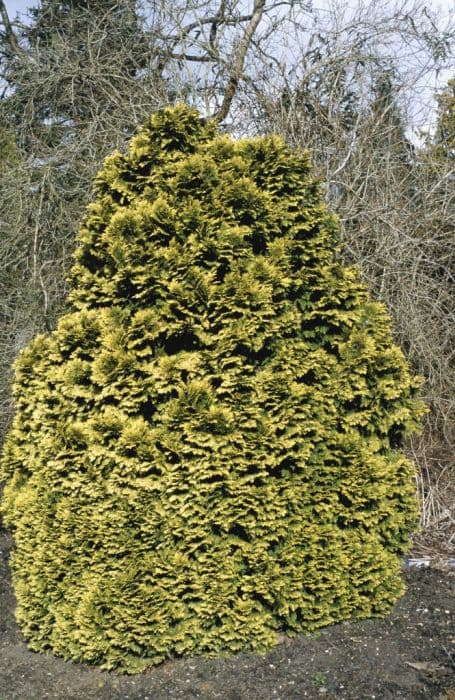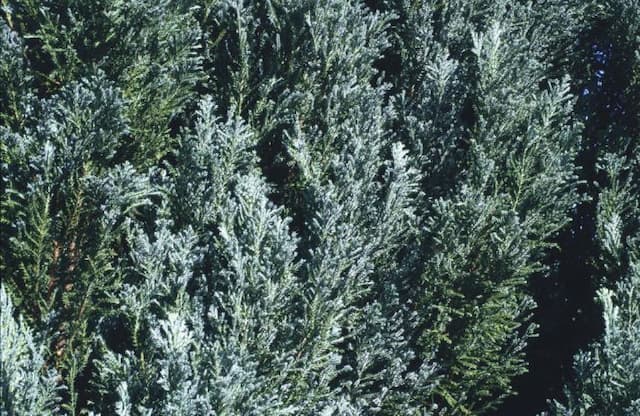Miniature Blue Lawson Cypress Chamaecyparis lawsoniana 'Minima Glauca'











ABOUT
The Chamaecyparis lawsoniana 'Minima Glauca', commonly known as Lawson's cypress or Port Orford cedar, features a compact and slow-growing form. Its foliage is an attractive shade of bluish-gray, which undergoes subtle color shifts with the changing seasons. The needle-like leaves are small and soft to the touch, enveloping the plant densely and sometimes exhibiting a hint of a silver or white flecking, giving it a frosted appearance. This cultivar forms into a conical or pyramidal shape, maintaining a neat and tidy silhouette without the need for frequent pruning. The fine texture of the foliage adds a softness to the landscape, contributing to its popularity in ornamental gardening. The overall impression of the Lawson's cypress 'Minima Glauca' is one of a delicate, blue-gray miniature tree with a refined structure, making it an excellent choice for adding evergreen interest to gardens without taking up a significant amount of space.
About this plant
 Names
NamesFamily
Cupressaceae
Synonyms
Dwarf Blue Lawson Cypress, Miniature Blue Lawson False Cypress, Miniature Blue Oregon Cedar
Common names
Cupressus lawsoniana, Chamaecyparis lawsoniana
 Toxicity
ToxicityTo humans
Lawson's Cypress, commonly known as Lawson's Cypress, is not known to be highly toxic to humans. However, as with many plants, individual allergic reactions or skin irritations can occur when handling the plant due to sensitivity to its oils or sap. Ingesting parts of the plant is not advisable as it may cause gastrointestinal discomfort, nausea, vomiting, or diarrhea in some individuals.
To pets
Lawson's Cypress may cause mild to moderate toxicity if ingested by pets. It is not one of the most toxic plants to pets, but symptoms of poisoning could include drooling, vomiting, diarrhea, or abdominal pain. Continuous exposure or large amounts ingested might lead to more severe symptoms, so it is advisable to prevent your pets from chewing on this plant. If you suspect your pet has ingested a significant amount of this plant, contact your veterinarian.
 Characteristics
CharacteristicsLife cycle
Perennials
Foliage type
Evergreen
Color of leaves
Blue-green
Height
3 feet (0.91 meters)
Spread
2 feet (0.61 meters)
Plant type
Shrub
Hardiness zones
5
Native area
North America
Benefits
 General Benefits
General Benefits- Low Maintenance: Lawson's Cypress 'Minima Glauca' does not require much maintenance, making it a convenient choice for a variety of landscapes.
- Drought Tolerance: Once established, this cultivar has a good level of drought tolerance, reducing the need for frequent watering.
- Aesthetic Appeal: The blue-green foliage of the plant adds a unique color and texture to the garden, enhancing visual interest.
- Compact Size: As a dwarf cultivar, it remains small, making it suitable for confined spaces and as a complement to other plants without overpowering them.
- Year-Round Interest: The evergreen nature of the plant ensures that it provides visual interest throughout all seasons.
- Wildlife Shelter: Provides shelter and sometimes food for wildlife like birds and beneficial insects.
- Soil Adaptability: It can adapt to a range of soil types, provided the soil is well-draining.
- Slow Growth: Its slow growth rate minimizes the need for regular pruning and maintenance.
- Windbreak: It can serve as a windbreak or natural screen when planted in groups or rows.
- Cold Tolerant: Exhibits a good level of cold tolerance, which is ideal for gardens in cooler climates.
 Medical Properties
Medical PropertiesThis plant is not used for medical purposes.
 Air-purifying Qualities
Air-purifying QualitiesThis plant is not specifically known for air purifying qualities.
 Other Uses
Other Uses- Port Orford cedar's wood shavings can be used in animal bedding for small pets like hamsters due to its absorbent nature and pleasant smell, reducing odors in pet enclosures.
- The dense foliage of Port Orford cedar can be sheared into intricate topiaries for ornamental garden features, showcasing the precision of the gardener.
- When dried and crushed, the leaves of the Port Orford cedar can serve as a natural insect repellent, keeping moths and other pests away from stored clothing.
- The wood can be used in the making of bows for archery, as it is both flexible and strong, making it an ideal material for this precise craft.
- Branches of Port Orford cedar can be used as natural holiday decorations due to their attractive form and color, as well as their resistance to drying out quickly.
- Wood from the Port Orford cedar can be carved into fine wooden jewelry or trinket boxes due to its fine grain and pleasant aroma.
- The bark of Port Orford cedar can be utilized as a natural mulch, providing a decorative ground cover that also helps retain soil moisture and suppress weeds.
- Port Orford cedar wood is also suitable for crafting musical instruments like flutes and recorders, offering superb sound quality.
- Fine sawdust from Port Orford cedar can be used in the creation of scent sachets, which imbue linen closets or drawers with a fresh, woodsy aroma.
- Port Orford cedar branches can be used for creating wreaths or garlands for festive occasions, due to their durability and ability to hold shape over time.
Interesting Facts
 Feng Shui
Feng ShuiThe Lawson's Cypress is not used in Feng Shui practice.
 Zodiac Sign Compitability
Zodiac Sign CompitabilityThe Lawson's Cypress is not used in astrology practice.
 Plant Symbolism
Plant Symbolism- Longevity: Also known as the Lawson Cypress, this plant can live for hundreds of years, symbolizing enduring life and steadfastness.
- Peace: The calm and evergreen nature of the Lawson Cypress often represents peace and tranquility, making it a symbol of serene environments.
- Healing: Since many conifers have medicinal properties, the Lawson Cypress can symbolize health and healing.
- Protection: Historically, evergreens like the Lawson Cypress were thought to ward off evil spirits, symbolizing protection and safety.
- Resilience: Able to withstand extreme conditions and still remain green all year, the Lawson Cypress is a symbol for resilience and adaptability.
 Water
WaterThe Dwarf Blue Lawson Cypress should be consistently watered to maintain moist soil, especially during its first growing season to establish a deep and extensive root system. After establishment, it can tolerate less frequent watering, but it’s important to avoid letting the soil dry out completely. During the growing season, water this conifer about once a week with approximately 1 to 2 gallons of water per session, depending on the size of the plant and the weather conditions. Keep a closer eye on watering during hot, dry spells, as the plant may require additional water to prevent stress.
 Light
LightThe Dwarf Blue Lawson Cypress thrives best in full to partial sunlight. It should be placed in a spot where it can receive at least 6 hours of direct sunlight each day. An ideal location would be in a garden area that is exposed to morning sunlight and receives some afternoon shade, especially in hotter climates, to protect the plant from scorching.
 Temperature
TemperatureThe Dwarf Blue Lawson Cypress prefers cool to moderate temperatures and is hardy in a range from 20 to 70 degrees Fahrenheit, though it can tolerate temperatures slightly below this range. Avoid placing it in locations where the temperature can drop below -10 degrees Fahrenheit, as extreme cold can damage the plant. The ideal temperature for this conifer is between 40 and 60 degrees Fahrenheit.
 Pruning
PruningPrune the Dwarf Blue Lawson Cypress to maintain its shape or to remove any dead or damaged branches. Pruning should be done in the late winter or early spring before new growth starts. This plant doesn't require frequent pruning; once a year is typically sufficient. When pruning, make gentle cuts and avoid cutting back into old wood as it may not regenerate.
 Cleaning
CleaningAs needed
 Soil
SoilThe best soil mix for the Port Orford cedar is well-draining, acidic to neutral in pH (around pH 5.0-7.0). A mixture containing peat moss, perlite, and organic compost is suitable for promoting healthy growth and preventing root rot.
 Repotting
RepottingPort Orford cedar, being a slow-growing conifer, typically needs repotting every 2 to 3 years to ensure it's not pot-bound and to refresh its soil.
 Humidity & Misting
Humidity & MistingPort Orford cedar thrives in moderate to high humidity levels; above 50% is ideal for this plant. It is important to maintain consistent humidity without fluctuations.
 Suitable locations
Suitable locationsIndoor
Place in well-lit area, avoid dry heat and direct sun.
Outdoor
Provide full sun, shelter from harsh winds, ensure well-drained soil.
Hardiness zone
5-8 USDA
 Life cycle
Life cycleThe Lawson's Cypress 'Minima Glauca' begins its life as a seed, which, after germination, grows into a small seedling characterized by its bright green, needle-like foliage. It then enters a juvenile phase, where growth rates are rapid, and the plant progressively develops the blue-gray, scale-like leaves for which this cultivar is known. As it matures, the Lawson's Cypress 'Minima Glauca' reaches maturity, developing a compact, conical form with dense branching and foliage, a phase that can last for several decades. During its reproductive phase, it produces small, inconspicuous cones that mature and release seeds, completing the cycle. The plant exhibits slow growth throughout its life, requiring minimal pruning and maintenance. Eventually, as the Lawson's Cypress 'Minima Glauca' reaches its later years, growth slows further and it may succumb to environmental factors, pests, or diseases, leading to its decline and end of life cycle.
 Propogation
PropogationPropogation time
Late Winter to Early Spring
The most popular method of propagating the Chamaecyparis lawsoniana 'Minima Glauca', commonly known as Miniature Blue Lawson Cypress, is through semi-hardwood cuttings. This typically occurs in late summer to early autumn, when the current year's growth has matured enough to slightly harden but still retain some flexibility. Cuttings of about 4 to 6 inches (10 to 15 centimeters) long are taken, with the lower leaves removed to expose a clear stem. The cut end can be dipped in rooting hormone to enhance root development before being placed into a soilless potting mix or perlite. The environment should be kept humid, and the soil consistently moist, but not waterlogged, until roots are established, which usually takes a few months. Once rooted, the young plants can be gradually acclimatized to less humid conditions before being transplanted outdoors.









